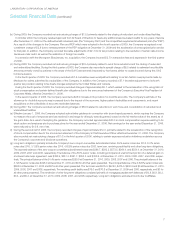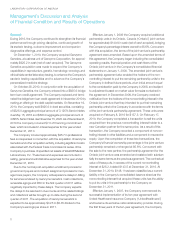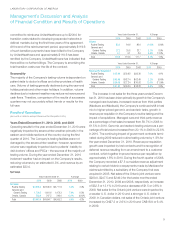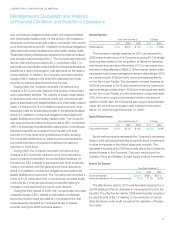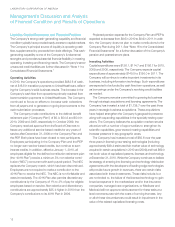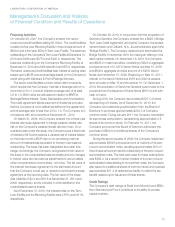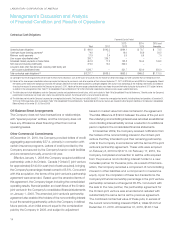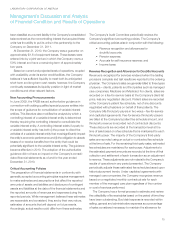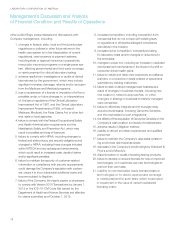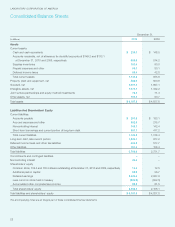LabCorp 2010 Annual Report Download - page 19
Download and view the complete annual report
Please find page 19 of the 2010 LabCorp annual report below. You can navigate through the pages in the report by either clicking on the pages listed below, or by using the keyword search tool below to find specific information within the annual report.17
LABORATORY CORPORATION OF AMERICA
Management’s Discussion and Analysis
of Financial Condition and Results of Operations
Return on Plan Assets
In establishing its expected return on plan assets assumption,
the Company reviews its asset allocation and develops return
assumptions based on different asset classes adjusting for
plan operating expenses. Actual asset over/under performance
compared to expected returns will respectively decrease/increase
unrecognized loss. The change in the unrecognized loss will
change amortization cost in upcoming periods. A one percentage
point increase or decrease in the expected return on plan assets
would have resulted in a corresponding change in 2010 pension
expense of $2.5.
Net pension cost for 2010 was $9.6 as compared with $36.6
in 2009 (including the impact of the $2.8 non-recurring net
curtailment charge). The decrease in pension expense in 2010
was due to the changes to the Company Plan and PEP. Projected
pension expense for the Company Plan and the PEP is expected
to decrease from $9.6 in 2010 to $8.9 in 2011.
Further information on the Company’s defined benefit
retirement plan is provided in Note 16 to the consolidated
financial statements.
Accruals for Self-Insurance Reserves
Accruals for self-insurance reserves (including workers’
compensation, auto and employee medical) are determined
based on a number of assumptions and factors, including histori-
cal payment trends and claims history, actuarial assumptions
and current and estimated future economic conditions. These
estimated liabilities are not discounted.
The Company is self-insured (up to certain limits) for
professional liability claims arising in the normal course of business,
generally related to the testing and reporting of laboratory test
results. The Company maintains excess insurance which limits
the Company’s maximum exposure on individual claims. The
Company estimates a liability that represents the ultimate
exposure for aggregate losses below those limits. The liability
is discounted and is based on a number of assumptions and
factors for known and incurred but not reported claims based
on an actuarial assessment of the accrual driven by frequency
and amount of claims.
If actual trends differ from these estimates, the financial
results could be impacted. Historical trends have not differed
materially from these estimates.
Income Taxes
The Company accounts for income taxes utilizing the asset
and liability method. Under this method deferred tax assets
and liabilities are recognized for the future tax consequences
attributable to differences between the financial statement
carrying amounts of existing assets and liabilities and their
respective tax bases and for tax loss carryforwards. Deferred
tax assets and liabilities are measured using enacted tax
rates expected to apply to taxable income in the years in
which those temporary differences are expected to be
recovered or settled. The effect on deferred tax assets and
liabilities of a change in tax rates is recognized in income in
the period that includes the enactment date. The Company
does not recognize a tax benefit, unless the Company
concludes that it is more likely than not that the benefit will
be sustained on audit by the taxing authority based solely
on the technical merits of the associated tax position. If the
recognition threshold is met, the Company recognizes a tax
benefit measured at the largest amount of the tax benefit
that the Company believes is greater than 50% likely to be
realized. The Company records interest and penalties in
income tax expense.
Forward-Looking Statements
The Company has made in this report, and from time to time
may otherwise make in its public filings, press releases and
discussions by Company management, forward-looking
statements concerning the Company’s operations, performance
and financial condition, as well as its strategic objectives.
Some of these forward-looking statements can be identified
by the use of forward-looking words such as “believes”,
“expects”, “may”, “will”, “should”, “seeks”, “approximately”,
“intends”, “plans”, “estimates”, or “anticipates” or the negative
of those words or other comparable terminology. Such
forward-looking statements are subject to various risks
and uncertainties and the Company claims the protection
afforded by the safe harbor for forward-looking statements
contained in the Private Securities Litigation Reform Act
of 1995. Actual results could differ materially from those
currently anticipated due to a number of factors in addition
to those discussed elsewhere herein and in the Company’s


